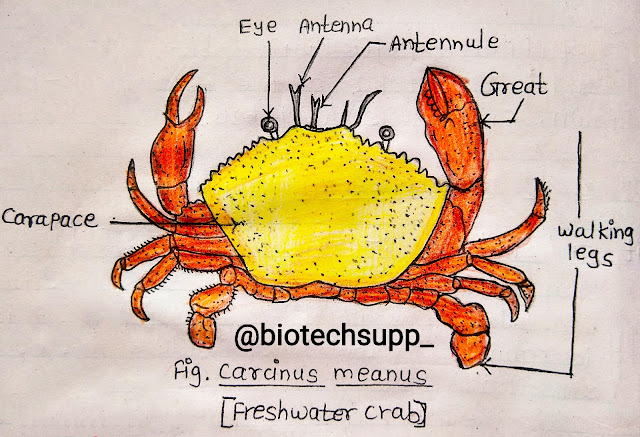Study of classification, habit, habitat and economic importance of:- Prawn, Crab, Oyster, Lobster.
Title :- Study of classification, habit, habitat and economic importance of the following - Prawn, Crab, Oyster, Lobster
1)Macrobrachium rosenbergii (Prawn) :-
•Habit and Habitat :- Macrobrachium rosenbergii is freshwater in inhibitant found in streams, rivers, ponds and lakes in central and South India. It is benthic animal and omnivorous feeding-algae, organic matter, insect larvae and small insects.
•Identification characters :- 1)Macrobrachium rosenbergii commonly called as fresh water prawn.
2)The body is elongated, spindle shaped and about 25-40 cm long.
3)The body is bluish green with brown or orange red patches.
4)Body divided into two parts an anterior cephalothorax and posterior abdomen. The cephalothorax is found formed by fusion of head & thorax and abdomen is formed by six-movable segments.
5)A pair of jointed appendages called pleopods. The second pair of walking leg is much larger than others.
6)The terminal conical piece of body is called 'Tail Plate' or 'Telson'.
7)The cephalic region carries five pairs of appendages namely antennules, antennae, mandibles, maxilluale and maxillae.
8)Prawn and Prawn products of India have much appreciation as food in international market, as it is highly nutritive, tasty and palatable.
2)Carcinus meanus (Fresh water) /
Scylla serrata (Marine water) :-
•Habit and habitat :- Crabs occur in freshwater, Marine, brackish water habitats. They generally shows aquatic respiration by gills. Crab is carnivorous, feeding Copepod, Shrimps and Small Fishes.
•Identification characters :-
1)Cephalothorax is large and covered by hard chitinous partly calcified carapace.
2)Cephalothorax have five pairs of head appendages and eight pairs of thoracic appendages. The last five pairs are legs.
3)First pair of legs is powerful called Chelate, used for capturing food. They also serve as organ of offense and defence. The remaining organs are used for swimming and walking.
4)Swimming organs are oar-like propulsion in water.
5)The gills are in several series in branchial chamber covered by carapace.
6)The abdomen is much abbreviated and kept fixed against the mid-ventral surface of thoracic region.
7)Abdomen of male is narrow with two pairs of uniramous appendages helpful in reproduction.
8)The abdomen of female broad with 4 pairs of biramus appendages for carrying the eggs in berried once.
9)Life cycle have two larval stages, the zoea and megalopa.
3)Pinctada margaritifera (Indian Pearl Oyster) :-
•Habit and Habitat :- Commonly Pearl Oyster is distributed in Gulf of Kutch, Gulf of Mannar, the Pay Bay and Indian Coast i.e. from Cape Comorin to Rameshwaram area. Oysters are cilliary feeder and feed on a variety of diatoms which is detritus material.
•Identification characters :-
1)Shell valves may be equal or unequal and shell surface is coarse, irregular ruffled.
2)Left shell valve is large, convex and permanently attached to rock, right shell valve is large, convex and permanently attached to rock. Right shell valve is smaller, thin and coarse viscera.
3)Gills plated with vertical folds and cilliated.
4)Only posteriors single adductor muscle present, which is very large and strong.
5)Body measures about 25 cm in length. 6)Oysters are economically very important because they produce high quality pearls as gems.
4)Palinurus polyphagus (Lobster) :-
•Habit and habitat :-
The Common Lobster found in Pacific and Atlantic Oceans and spiny or rocky Lobsters found in Indian water under rocks, Coral reefs and muddy bottom of seas. Lobsters are Primarily Scavengers feed on carrions but also feed on Polychetes, Molluscs, Crustaceans.
•Identification characters :-
1)Body divisible in Cephalothorax and Abdomen. Abdomen ends into a fan-like tail fin.
2)Telson and Uropods reddish-tinged; legs brownish red with cream coloured jointed. 3)Cephalothorax and Abdomen is muddy brown in colour. Carapace shows a row of six white spots on lateral side.
4)Cephalothorax covered by chitinous carapace.
5)Stalked eyes, a pair of antennules and a pair of antennae.
6)Five pairs of walking legs, prominent and strong.
7)Abdomen bears five pairs of uniramous pleopods which are small and leaf like.
8)Carapace bears spines.
9)In male, the third leg is longest which help in copulation.
10)In earlier days, Lobsters was food of poor people but now it becomes a delicious food item in Western Countries.
_______________THANK YOU_______________









Post a Comment